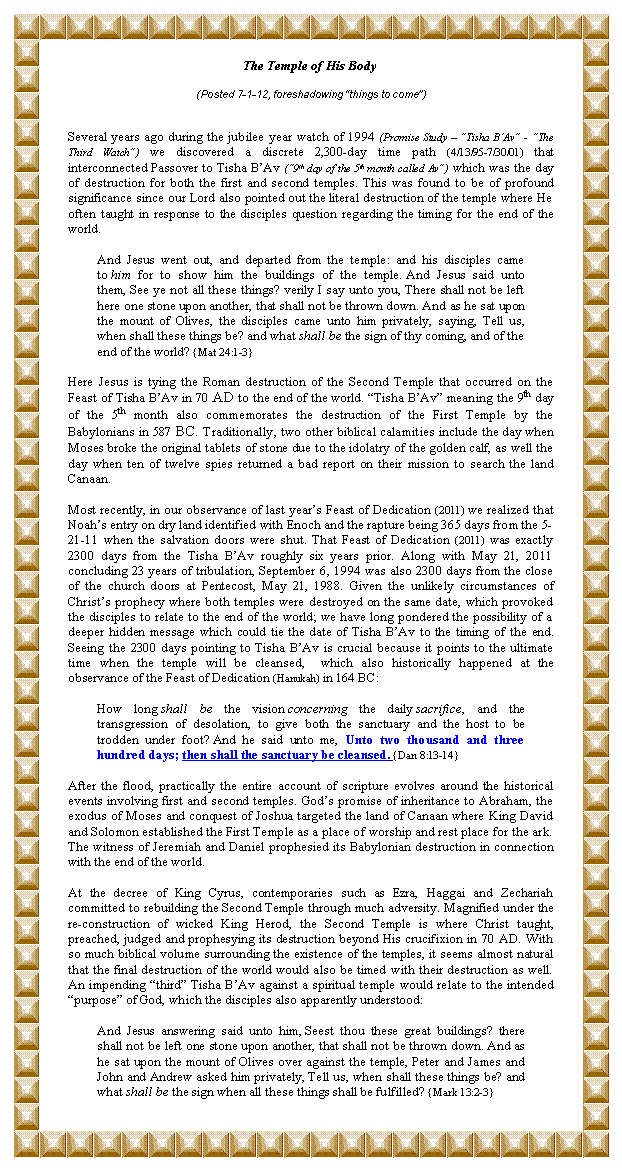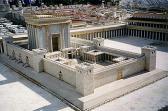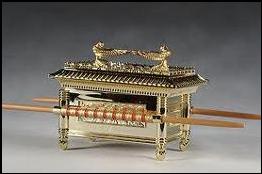

Ark of the Covenant |



|
The First Temple, decreed under the reign of King David, took seven years to build by Solomon, his successor. Solomon spent thirteen years building his own house. (1King 7:1) The Lord promised him continued material and spiritual prosperity if he would only be like King David his father. The grand temple was built under God’s detailed instructions with a standard of luxury unprecedented in its time. Upon the seven-year completion, Solomon hosted an elaborate dedication and brought in the Ark of the Covenant. (1Kings 8:65-66) The dedication, lasting “eight days,” preceded the observance of the Feast of Tabernacles. After the dedication the Lord re-appeared and assured Solomon that indeed the temple had been blessed (2 Chronicles 7:1-6). The chronology of this account is closely resembles the our experiences lived today. Seven thousands years after the flood in 2011, God’s remaining watchman observe the Feast of Tabernacles in dedication to the wait and hope of the promise until the Lord’s reappearance. From the temple’s destruction 587 BC to the year of spiritual restoration 2014 AD equals 2,600 years = 2³ × 5² × 13. |
|
The Ark of the Covenant was designed for the Lord’s purpose to contain the two tablets of stone that inscribed the Ten Commandments, which God gifted the children of Israel specifically on Pentecost at Mount Sinai (Exodus 19:16, 20:1...). The Ten Commandants represents the Word of wisdom which is the “Tree of Life,” a phrase God incorporates “ten” times in scripture. (Rev 22:14, Proverbs 3:13-19) Being presented on Pentecost, the “Ten Commandments” point to the final ten-day “Sabbath journey” the disciples had to travel to Jerusalem from the point where Christ had ascended (Acts 1:11-12) . Counting 50 (5 x “10”) weeks from the Spiritual Harvest date 5-21-12, the Promise studies have led to this year’s Ascension date May 8-9, 2013 to be the pivotal starting point for the final time-path (10 weeks) to the end in “like manner” to the disciples’ promise journey to Jerusalem (the word “promise” is found “50” (5x10) times in the bible). May 8, 2013 also matches Noah’s covenant dry-land date being the 27th day of the 2nd month (Gen 8:14-16). Exactly ten weeks (Sabbaths) later is Tisha B’ Av - 2013, which memorializes the destruction of both the First and Second Temples; the very same event that Christ relates and prophesizes on Mount Olives where He also ascended as “the end of the world.” (Matt 24:1-3) In parallel according to Jewish custom, the word used for ascend is “aliyah” which refers to the Diaspora or “ascent to Jerusalem,” It also refers to the honor of “going up” to the reading of the torah. |
|
The Promise of His Coming |
|
As noted the Ark of the Covenant contained the two tablets of stone during Israel’s exodus from Egypt, which means that the Ten Commandments were intimately identified with God’s covenant or “promise” of eternity. ”This is the covenant that I will make with them after those days, saith the Lord, I will put my laws into their hearts, and in their minds will I write them; And their sins and iniquities will I remember no more.” {Heb 10:16-17} The Hebrew word for the “ark” (Strong # H727) of the promise is “aron” and represents the presence of the Lord. Alternatively, in Gen. 50:26 the very same word aron is used for the “coffin” of Joseph who like Jacob harmoniously lived “110” years old. In other words, the two men of God lived until he fullness of their time plus a final “ten-period” journey to the promise. Jacob and Joseph were buried with their fathers in the land of inheritance (Canaan) purchased by Abraham (Gen 49:29-33).
The Hebrew root word for Noah’s “ark” is different from the word used for the “ark” of the covenant. The ark of Noah stems from Strong’s translation of “tebah” (H8392) , which is also the same word used for the basket that rescued infant Moses from the hand of Pharaoh. In this case the word “ark” emphasizes God’s protection and deliverance from certain death.
However, as with English, the Greek translations in the New Testament ties all the “arks” together by using the same word for box (“Kibotos” - G2787) to translate the “ark of Noah” as well as the “ark of the covenant.” (See Hebrews 9:4 vs. Hebrews 11:7) |
|
~ Excerpt from Promise study # 13 ~ |
|
Excerpt from Promise study # 13 |
|
Many Infallible Proofs |
|
The Fig Tree |
|
Biblical Time-line |
|
A Foregone Conclusion |

|
And as he sat upon the mount of Olives, the disciples came unto him privately, saying, Tell us, when shall these things be? and what shall be the sign of thy coming, and of the end of the world? {Matthew 24:3} |
|
Hezekiah’s sign... |
|
Prophetic Harmony |
|
With Tisha B’ Av (July 16, 2013) falling exactly “70 days” from the dry land date May 9, 2013 (27th day of the 2nd month - New Moon Solar Eclipse) and exactly 10 weeks prior to the last day of Tabernacles 2013; it turns out that our ultimate conclusion regarding the timing of the destruction of the temple (Tisha B’Av) is actually the “SIGN” of Hezekiah’s sundial returned 10 degrees backwards to know when to go up to the house of the Lord on the third day... (2 Kings 20:8-11) |
|
7-1-12 |